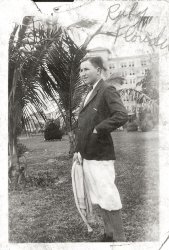
MAY CONTAIN NUTS

Search Shorpy
SHORPY ART

Framed or unframed, desk size to sofa size, printed by us in Arizona and Alabama since 2007. Explore now.
Join and Share
Ad-Free Shorpy
Shorpy is funded by you. Patreon contributors get an ad-free experience.
Learn more.

Recent comments
- Lofty addition
- In 1912
- Keenan Building
- Six years old
- Taken from the P.J. McArdle Roadway?
- It stood only 47 years
- Three track mind
- Incline to the right
- Reach for the sky, 1912 style
- No clean sweep
- Same Job Title, Same Face
- Sadly Lost
- Beautiful ...
- Where you get your kicks
- Aim High
- Pueblo Revival sisters
- Pueblo Neoclassicism
- Milk Man
- Regional dialect.
- Spielberg's inspiration
- Great Photo
- Loaf Story
- Do you still have the Rakes category?
- Could almost be a scene from the 1957 movie 'Hell Drivers'
- The Wages of Fear.
- Conspicuous by their absence
- Got Milk?
- All that aluminum
- No lefties
- Smoke 'em if you've got 'em
Member Photos
The Shorpy
Print Emporium
Print Emporium
Search Shorpy
Search results -- 30 results per page
- Spring Break: 1941
- March 5, 1941. "Raleigh Hotel, Collins Avenue, Miami Beach, Florida. Pool from center. L. Murray Dixon, architect." ... the world my grandmother would take her mink wrap down to Miami Beach. (Wrap: bigger than stole, smaller than coat.) Was it ever cool ... Posted by Dave - 03/15/2013 - 10:22am -
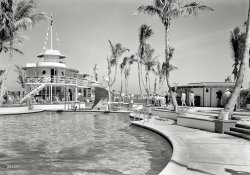
- Palm Beach: 1905
- Florida circa 1905. "The Palm Beach 'trolley.' " Early development in the Sunshine State. 8x10 inch dry plate ... on 1 HP.
Old Florida Having grown up in South Miami, I'm loving this series.
Anyone who attended South Florida schools in ... Posted by Dave - 07/27/2012 - 4:53pm -
![Palm Beach: 1905 Florida circa 1905. "The Palm Beach 'trolley.' " Early development in the Sunshine State. 8x10 inch dry plate glass negative, Detroit Publishing Co. View full size.
Flagler hotelsThis trolley led from the the gargantuan Hotel Royal Poinciana about a half mile east to the Breakers on the ocean. Guests could also choose to take the palm-lined "Ocean Walk."
The hotel closed around 1930 and was razed in 1936. It was the largest wooden structure in the world when it was built.
http://royalpoincianahotel.blogspot.com/
A quibbleis that the term "trolley" refers to the apparatus for picking up electrical power from an overhead wire, absent in this case.
[The word meant "cart." As in horse trolley. It eventually came to be applied to the apparatus drawing electrical current from overhead wires to power a trolley car. Strictly speaking, this conveyance is a horsecar. Which is why the caption puts the word trolley in quotes. - Dave]
JustificationAnother reason I visit Shorpy every day is to give myself a linguistic tuneup.
Trolleys = Go-kartsIn New Zealand (and probably other places) go-karts are "trolleys." There are annual "trolley races" all over. A friend is an organizer for one.
Flagler SystemThe trolley is owned by Henry Flagler's Florida East Coast Railroad. Flagler was the man most responsible for early real estate development and resort building in Florida, bringing all interested parties down there via his own railroad, which ran all the way to Key West, with ferry service to Havana.
HorsepowerWhatever it is, it gets around on 1 HP.
Old FloridaHaving grown up in South Miami, I'm loving this series.
Anyone who attended South Florida schools in the 1960s would know all about Henry Flagler and his railroads and hotels. If I'm ever offered a time machine, my first trip will be to South Florida and the Keys circa 1900. It's wall-to-wall concrete now even compared to when I was a kid, but the pristine, undeveloped wilderness of the area must have been stunning at the time.
(The Gallery, DPC, Florida, Horses, Streetcars)](https://www.shorpy.com/files/images/4a12557a.thumbnail.jpg)
- Foot Traffic: 1942
- ... January 21, 1942. "Mangel's, 130 E. Flagler Street, Miami, Florida. Exterior, night. Ross-Frankel Inc., client; Morris Lapidus, ... Lapidus also designed the Fontainebleau Hotel in Miami Beach - once the most glamorous of Miami Beach's hotels - which opened in 1954 ... Posted by Dave - 09/07/2013 - 11:42am -
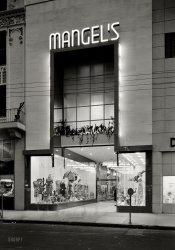
- Dodge Noir: 1948
- ... for his hotel designs (most famously, the Fontainebleau in Miami Beach) where he tried to transform the guest experience into an extravaganza. ... Posted by Dave - 02/05/2013 - 8:43am -
![Dodge Noir: 1948 March 24, 1948. "L Motors, business at 175th Street and Broadway, New York City. General view. Morris Lapidus, client." Need a new car? Go straight to L. Large-format acetate negative by Gottscho-Schleisner. View full size.
I wishI could have taken this. It's beautiful.
Morris LapidusVery well known for his hotel designs (most famously, the Fontainebleau in Miami Beach) where he tried to transform the guest experience into an extravaganza. He wanted people to always remember their visit and did all he could to make it visually memorable. This car dealership is flamboyant to the nth degree. Beautiful.
Still ThereToday it's a "Bravo Super Market."
Bravo? I think not.Via Google Streetview: http://goo.gl/maps/UhLBC
Not much to look at nowadays. This is progress?
[Edited to add: Sorry, I thought I uploaded this pic with my post:]
Two ThingsCould that car in the showroom window possibly be on a turntable? And what's that leaning out of the driver's window? A kid? A mannequin?
Keepin' it realRegarding the inquiry by "The Inventor" about the object in the driver's seat, I think it is probably a prop to inspire spectators to imagine themselves in the car. The convertible in the far right window appears to be full of passengers and/or dogs (but I know for sure they are not giant hamsters).
TowniesThe 175th St & Broadway neighborhood is the Washington Heights section of Manhattan. At he time this picture was taken it was was a multi ethnic enclave. Heavily Jewish, with a high proportion of German refugees that arrived both before and after WW2. Some of the more well known people that grew up there were former Secretary of State Henry Kissinger, the stage and film Producer/Director Mike Nichols and "The Fonz", Actor/Director Henry Winkler.
"The Nighthawks"That photo reminds me very much of the Edward Hopper painting.
A sign of changing transportation times (sort of)The streetcar tracks shown on Broadway were no longer in use at the time of the photo, the streetcar lines having been discontinued about nine months earlier. It would be tempting to say that the expansion of private auto ownership as exemplified by the cars in the window was the reason for the abolition of the streetcars, which would be true in most parts of the country, but in New York the switch to buses was the main reason.
WhatsaWhat's a "Plymouth".
What's a two-phase traffic light.
Statements of yesteryore, not questions. Ahhh. Sigh.
A Shadow of its Former Glory - 2009R&S Strauss Discount Auto: http://bit.ly/Xq1ssy
(The Gallery, Cars, Trucks, Buses, Gottscho-Schleisner, NYC)](https://www.shorpy.com/files/images/SHORPY_5a14840u.thumbnail.jpg)
- Villa Carlesia: 1939
- ... "Part of Florida home in wealthy residential section. Miami Beach, Florida." Acetate negative by Marion Post Wolcott for the Farm Security ... Posted by Dave - 04/27/2021 - 9:31am -
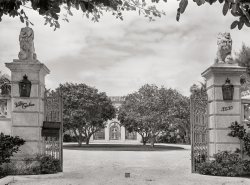
- Gulf Service: 1939
- April 1939. "Miami Beach, Florida. Even the gas stations are on an elaborate scale, often modern ... canopy Shows very little fear of heavy snows in Miami. Love to see how it is engineered.
Wheelan's Fish Grill is Gone ... Posted by Dave - 04/25/2019 - 6:45pm -
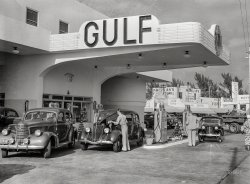
- Xanadu: 1897
- ... East Coast Railway, the first rail line to reach Palm Beach, Miami, and eventually Key West. He employed the fledgling architecture firm of ... Posted by Dave - 08/13/2012 - 7:57pm -
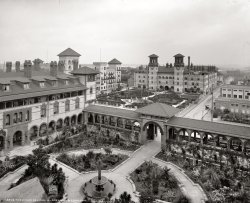
- Roney Plaza: 1939
- April 1939. "Collins Avenue. Entrance to one of Miami Beach's better hotels." Medium format negative by Marion Post Wolcott for the ... Posted by Dave - 05/01/2019 - 9:50pm -
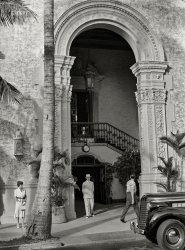
- A Different Drummer: 1925
- ... (Hugo Hespen of Washington) and niece (Etta Pfrommer of Miami Beach)
Washington Post, Feb 2, 1936
The Washington ... Posted by Dave - 09/04/2012 - 4:54pm -
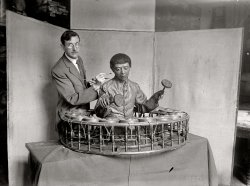
- Aquacabana: 1941
- March 5, 1941. "Raleigh Hotel, Collins Avenue, Miami Beach, Florida. Snack bar. L. Murray Dixon, architect." Gottscho-Schleisner ... Army Air Forces Training Command requisitioned over 300 Miami Beach hotels, including the Raleigh. They were used both as residences ... Posted by Dave - 10/15/2013 - 9:44am -
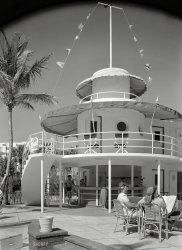
- Concrete Cadillac: 1964
- "Collins Avenue, Miami Beach, 1964." Showing further progress in the application of asphalt and cement ... my parents had a wooden hanger that says "Cadillac Hotel, Miami FLA". To my knowledge neither one visited Miami. I ended up with it and ... Posted by Dave - 07/16/2015 - 1:05pm -
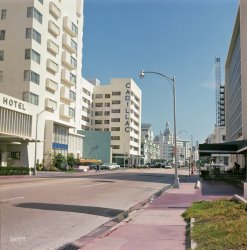
- Surfside '64
- 1964. "Miami Beach from Indian Creek." The Fontainebleau Hotel at left. Medium format color ... full size.
Olds, Pontiac, Chevy, oh my! Seems Miami Beach prefers GM vehicles.
I see a couple Ramblers and a lot of ... Posted by Dave - 07/19/2015 - 5:56pm -
![Surfside '64 1964. "Miami Beach from Indian Creek." The Fontainebleau Hotel at left. Medium format color transparency, photographer unknown. View full size.
Olds, Pontiac, Chevy, oh my!Seems Miami Beach prefers GM vehicles.
I see a couple Ramblers and a lot of Falcons and a few other Fords, but the majority seem to be GM product.
Goldfinger?This looks an awful lot like the Miami Beach location that kicks off GOLDFINGER (1964) or very close to it.
[There's a reason for that. -tterrace]
(The Gallery, Kodachromes, Cars, Trucks, Buses, Florida, Found Photos, Miami)](https://www.shorpy.com/files/images/SHORPY-373-01.thumbnail.jpg)
- Morris Lapidus: 1946
- ... The architectural ubermensch of Miami Beach, best remembered for the Fontainebleau Hotel .
Dec. 13, 1946. ... Posted by Dave - 04/16/2014 - 9:05am -
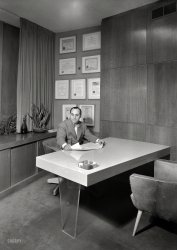
- Sand Dancers: 1922
- July 6, 1922. "People dancing on beach." Pavilion at the Potomac bathing beach in Washington. View full size. National Photo Company Collection ... I've gone to swing dances in Seattle, L.A, Chicago and Miami, and have seen Balboa in all those fine cities.
(The Gallery, D.C., ... Posted by Dave - 09/11/2011 - 10:49am -
![Sand Dancers: 1922 July 6, 1922. "People dancing on beach." Pavilion at the Potomac bathing beach in Washington. View full size. National Photo Company Collection glass negative.
The FellowThird from the left (with his arms folded across his chest) appears to be the same person from "When We Were Young", also standing on the left side of the photo (note the logo on the bathing suit).
[Same guy, but the swimsuits are different. - Dave]
TuberPoor kid with the innertube would have had a tough time hanging onto that skinny thing. My dad was in heavy construction, and we would occasionally be gifted with a huge truck tire tube which was almost too big to climb up on while in the water. Plus, we wore out our arms inflating those things with a scrawny bicycle pump.
Digging those dressesThe (swim?) dresses with the stripes that those girls have one (like the girl far right next to innertube guy) are too cool.
Let's do the BalboaThese folks look to be doing the "Balboa," a dance that started in the mid-teens in SoCal. Not much is known about the dance, but likely stems from the same roots as Lindy Hop, Collegiate Shag, and other forms of swing dance. Bal was often done on beaches as opposed to other swing dances because it is more of a shuffle step.
Oh, and there was the small matter of it typically being a full-body contact dance... most of the lead was in the body connection. Although, in these bathing suits, a full-body lead would be... erm... a bit interesting for the guys, to say the least.
Balboa is alive and well.Balboa is being danced all over the place; it's a great dance for super-fast tempos like Dixieland. I've gone to swing dances in Seattle, L.A, Chicago and Miami, and have seen Balboa in all those fine cities.
(The Gallery, D.C., Natl Photo, Sports, Swimming)](https://www.shorpy.com/files/images/06641u.thumbnail.jpg)
- Five o'Clock Shadows: 1939
- April 1939. "Miami Beach home of former Gillette Razor Blade Company president." Medium format ... who endured an impoverished rural lifestyle.
Neither Miami Beach nor its residents would seem to qualify as subject matter.
... Posted by Dave - 04/30/2019 - 10:33pm -
![Five o'Clock Shadows: 1939 April 1939. "Miami Beach home of former Gillette Razor Blade Company president." Medium format negative by Marion Post Wolcott for the Farm Security Administration. View full size.
Those Palm TreesNeed a shave and a haircut. For two cents I would give them one.
FSA subject matter?What was Wolcott trying to tell us with this photo?
The FSA was created to assist poverty-stricken farmers and its photographers were tasked to document the lives of those who endured an impoverished rural lifestyle.
Neither Miami Beach nor its residents would seem to qualify as subject matter.
[The mandate of the FSA photography project, as distinct from the Farm Security Administration itself, evolved after the Dust Bowl years to include the documentation of American life in general, as well as Resettlement Administration activities. Three years after this, it became the Office of War Information photography project. - Dave]
Sharp looking house!Bet a lot of cutting edge technology went into the construction.
Gerard LambertHe was the son of the founder of Listerine, but worked hard to make a name for himself. Princeton Magazine has a great article about him.
(The Gallery, Florida, M.P. Wolcott, Miami)](https://www.shorpy.com/files/images/SHORPY-8c09809a.thumbnail.jpg)
- Ahead of the Curve: 1955
- March 30, 1955. "Fontainebleau Hotel, Miami Beach. Over pool to hotel. Morris Lapidus, client." The luxe hostelry's first ... enjoy!
(The Gallery, Florida, Gottscho-Schleisner, Miami) ... Posted by Dave - 08/04/2013 - 2:18pm -
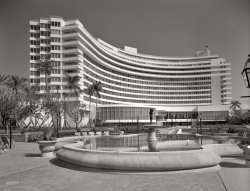
- Fly BOAC: c.1958
- ... "Back in the U.S.S.R." stuck in my head - "Flew in from Miami Beach B.O.A.C...." Thanks for a great historic picture of one of my favorite ... Posted by Rute Boye - 07/13/2012 - 10:37pm -
![Fly BOAC: c.1958 This is one of many color slides that my father shot when we lived in the San Francisco area in the mid to late 1950's. This particular shot was taken on Anscochrome film and shows Union Square in downtown SF. Note the overhead wires for the electric buses. I have many more like this, which I'll try to post as time allows. View full size.
A Corvette!Gimme that Vette, please!
Time LineThat 1958 Chevrolet looks like the newest car in the pic. This would make the earliest date fall of 1957. I don't remember that chrome piece at the rear of the back window.
[That bit of chrome was specific to certain Bel Air models. - tterrace]
A rare body styleThe Corvette is cool, but I'll take the '58 Bel-air hardtop. In fact, I had one almost exactly like it, bought it used in 1962 to go to college in. 1958 was a rare year for the entire GM lineup. The cars were new from the 55-57 group, but strangely not repeated in 59. The 58 models had another distinction––there were more available body styles than in 57 and previous years, or 59 and succeeding years. The one pictured here was a rare variation of the Bel-air 4-door hardtop. Most Bel-air 4-door hardtops had a slightly different treatment of the roofline and rear door pillars. This one is white over silver blue. Mine was silver blue over white, otherwise this car would be identical to mine. The car was a dreamboat and proved at college to be an incredible chick magnet. Co-eds loved to ride in it at night with the windows down, and my buddies and I loved to oblige them. BTW, the "V" emblem on the hood indicates a V8 engine, the soon to be famous "small block" Chevy. First year with 283 cubes, too. What a car!
B O A CAs our Brit friends explain it, "Better On A Camel"!
Thanks to DbellI sing with a community chorus, and we just wrapped up a concert series that was all music from the Beatles. Thanks to Dbell's pointing out the B.O.A.C. sign, I now have "Back in the U.S.S.R." stuck in my head - "Flew in from Miami Beach B.O.A.C...." Thanks for a great historic picture of one of my favorite cities!
(ShorpyBlog, Member Gallery)](https://www.shorpy.com/files/images/Union_Square_1.thumbnail.jpg)
- Semmes City: 1926
- ...
1940 sees him as a real estate salesman in Miami Beach, with most of his children still with him, but no mother-in-law.
Mary ... Posted by Dave - 06/22/2018 - 11:28am -
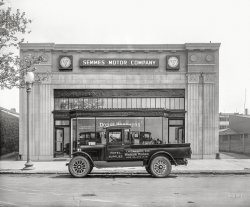
- Gulf Hotel: 1939
- ... Street.
April 1939. "Even the gas stations in Miami Beach are on an elaborate scale, often modern design, resembling hotels." ... Posted by Dave - 04/26/2019 - 11:58am -
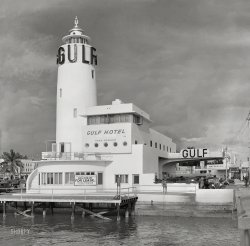
- Goodyear Blimp: 1956
- ... 35mm Kodachrome slide was taken by my grandfather in the Miami/Miami Beach area around 1956. View full size.
The Blue Auto Is that a 1957 ... Posted by JohnZ14 - 09/03/2016 - 2:03pm -
![Goodyear Blimp: 1956 This 35mm Kodachrome slide was taken by my grandfather in the Miami/Miami Beach area around 1956. View full size.
The Blue AutoIs that a 1957 Mopar product?
[1957 Plymouth. -tterrace]
Taking the limp out of BlimpPlus a 1958 Chevrolet a few cars back. Its a great picture of the Goodyear Blimp . Goodyear is replacing its fleet of 3 Blimps with craft that have rigid frames . But don't worry they won't be calling them the Goodyear zeppelins .
57 FuryLooks to be a 1957 Plymouth Fury, a very baseline model.
[The lack of side panel trim shows it to be a Plaza 2-door business coupe. -tterrace]
(ShorpyBlog, Member Gallery)](https://www.shorpy.com/files/images/GoodyearBlimp_1956.thumbnail.jpg)
- Dad the Golfer
- ... My dad in 1924 going to play a game of golf. Taken in Miami Beach, but where I'm not sure. View full size.
(ShorpyBlog, Member ... Posted by snoebay88 - 04/11/2009 - 11:25am -
